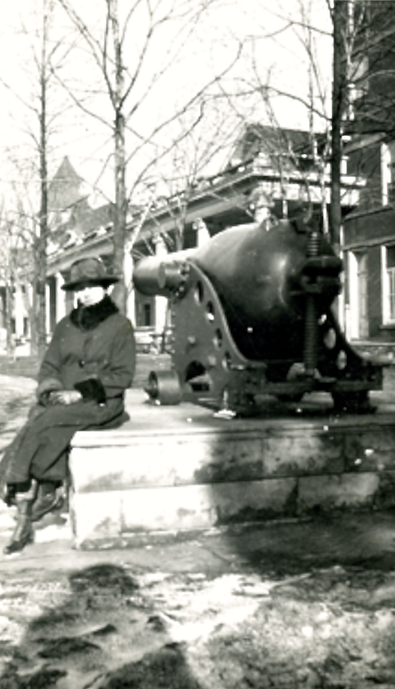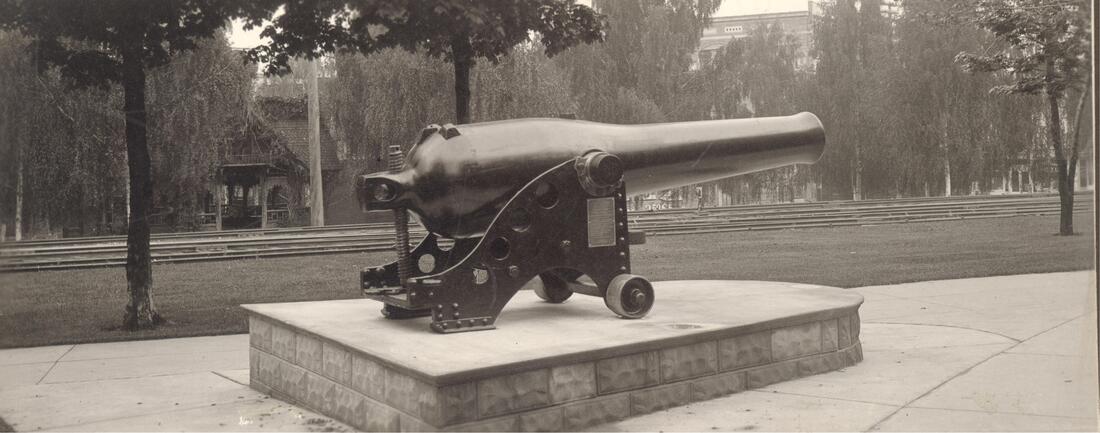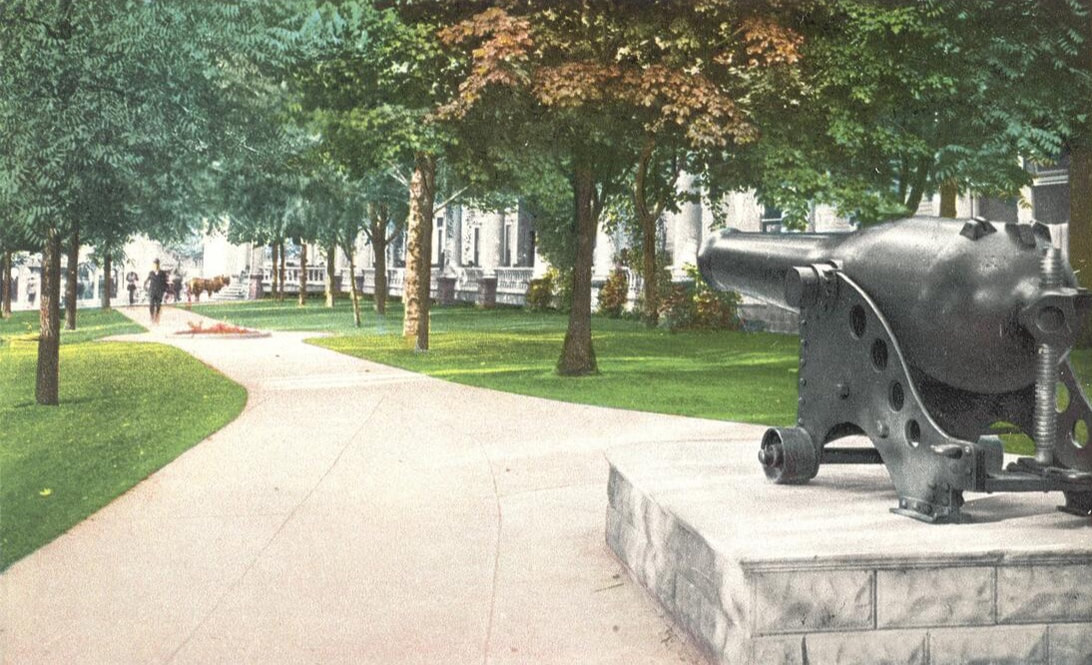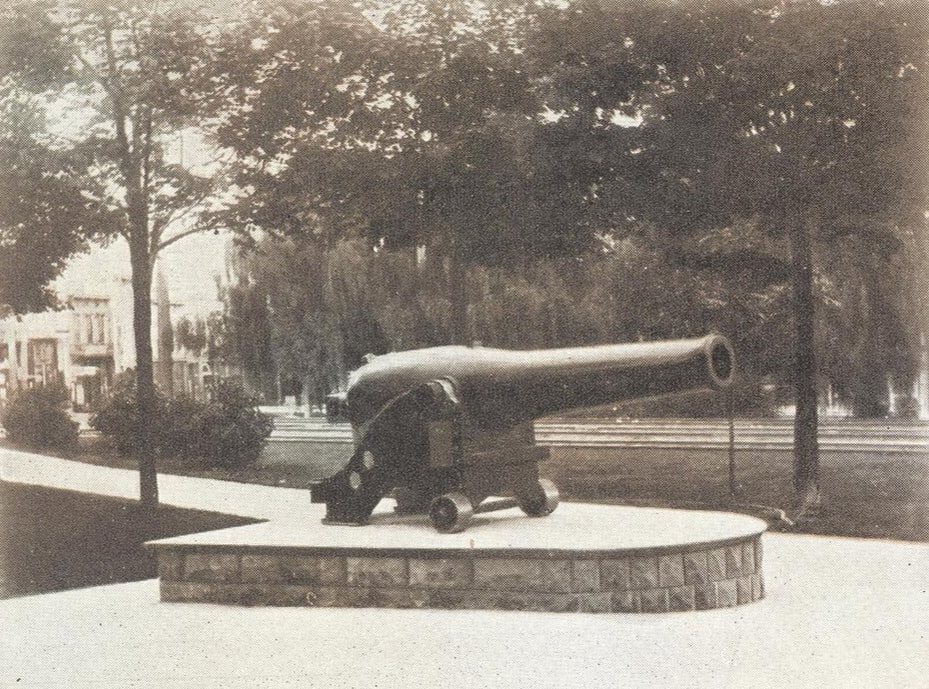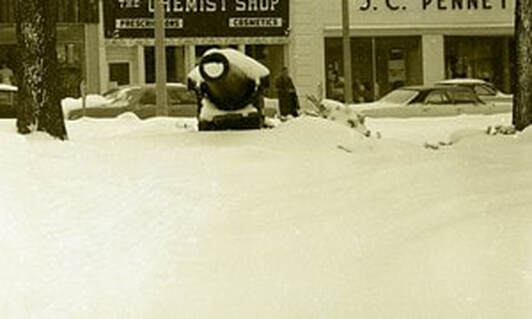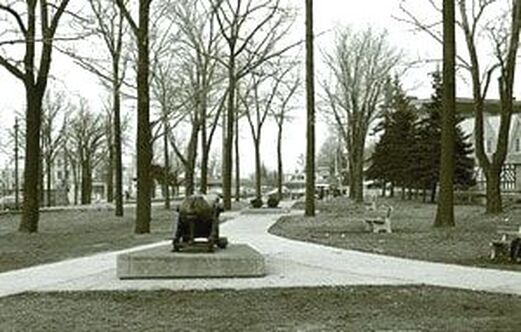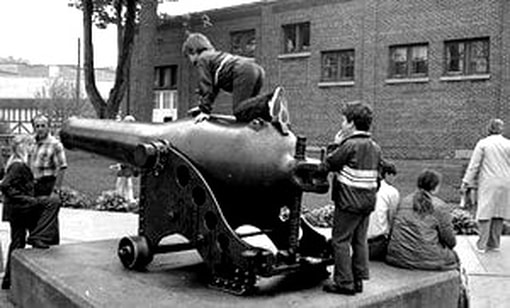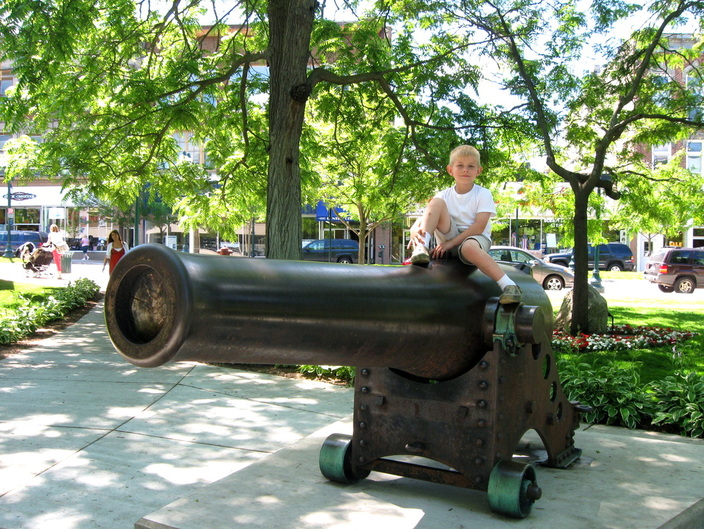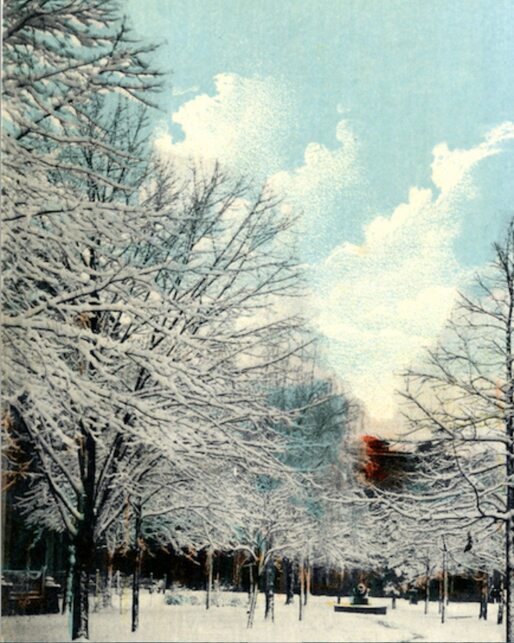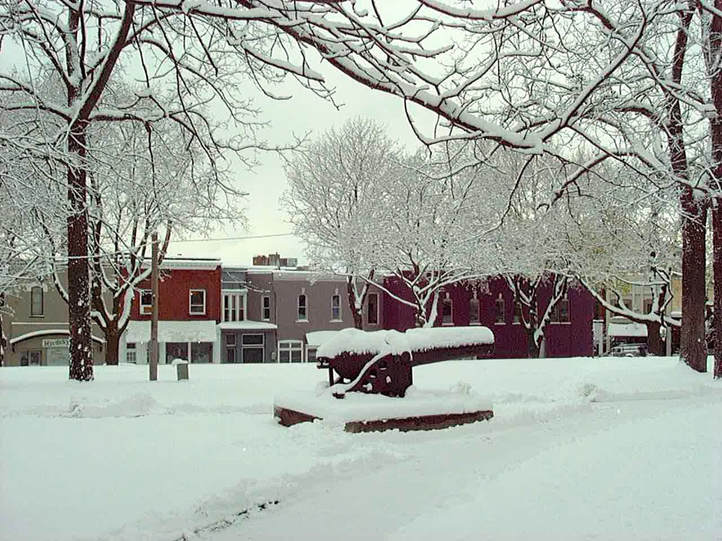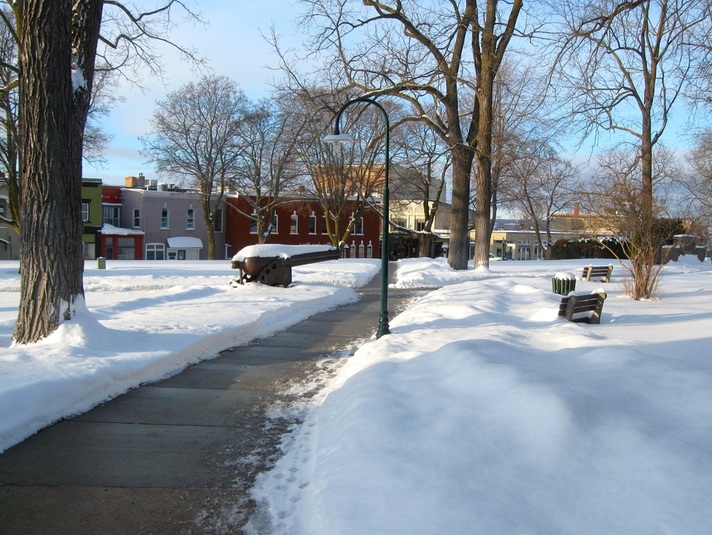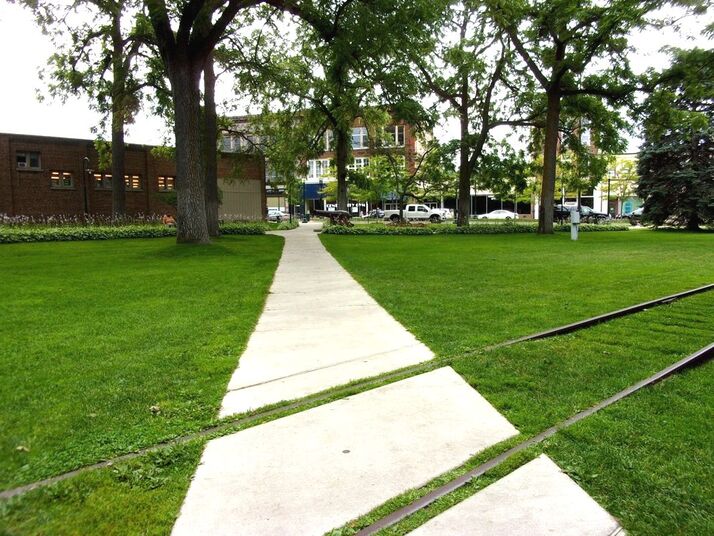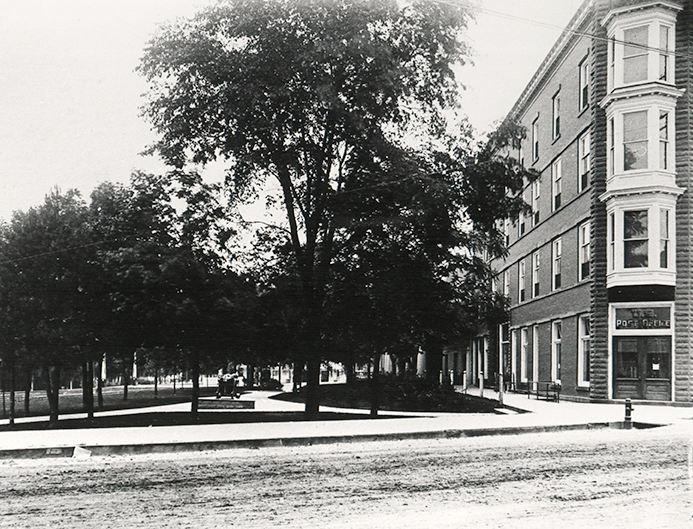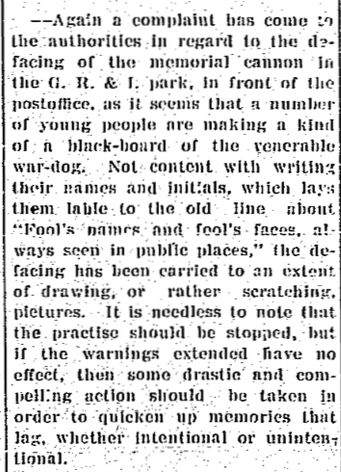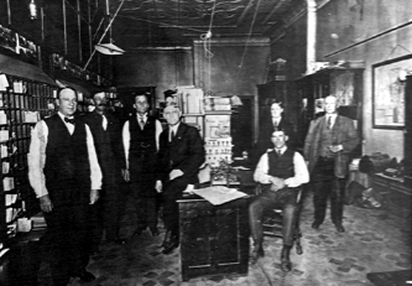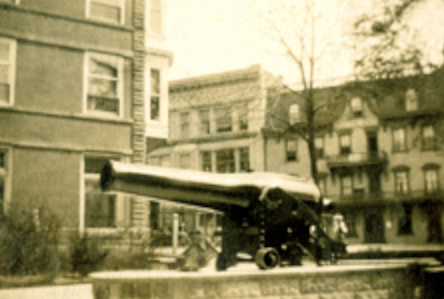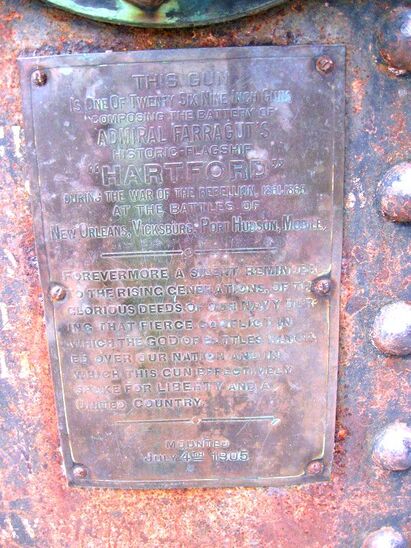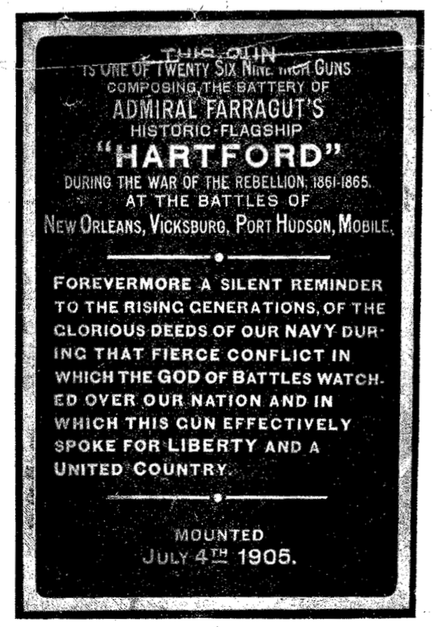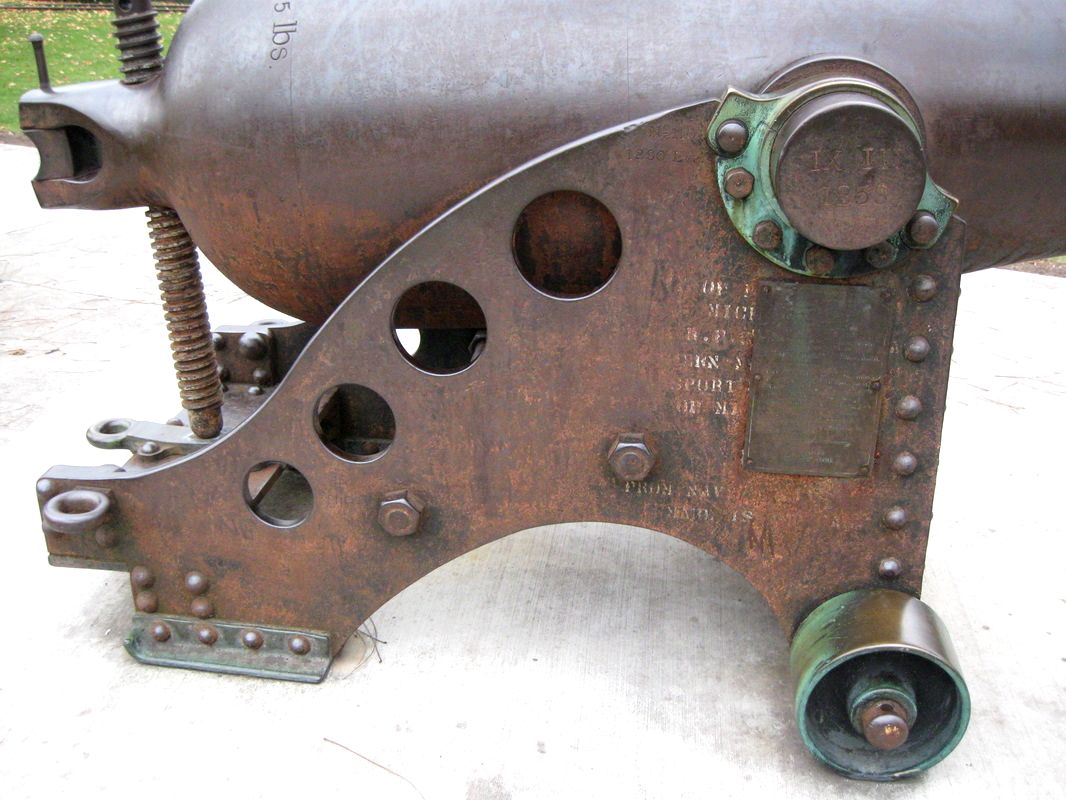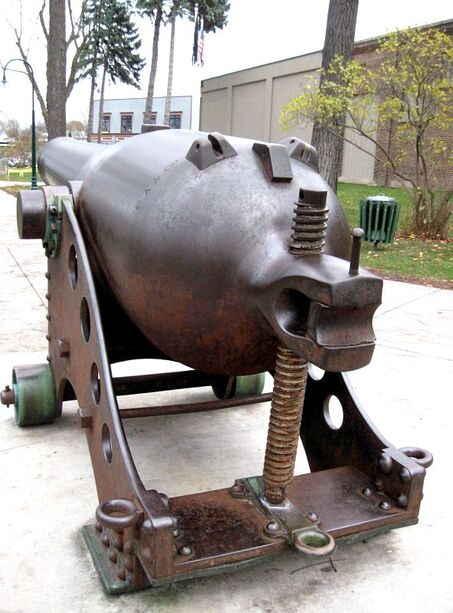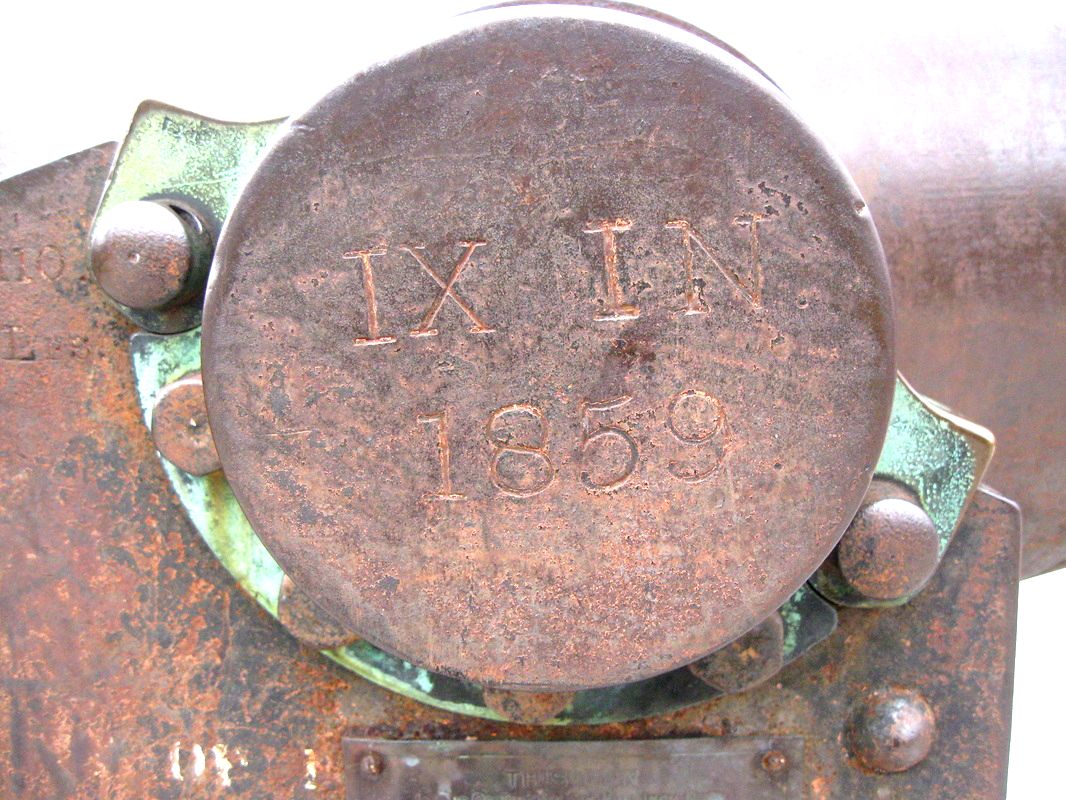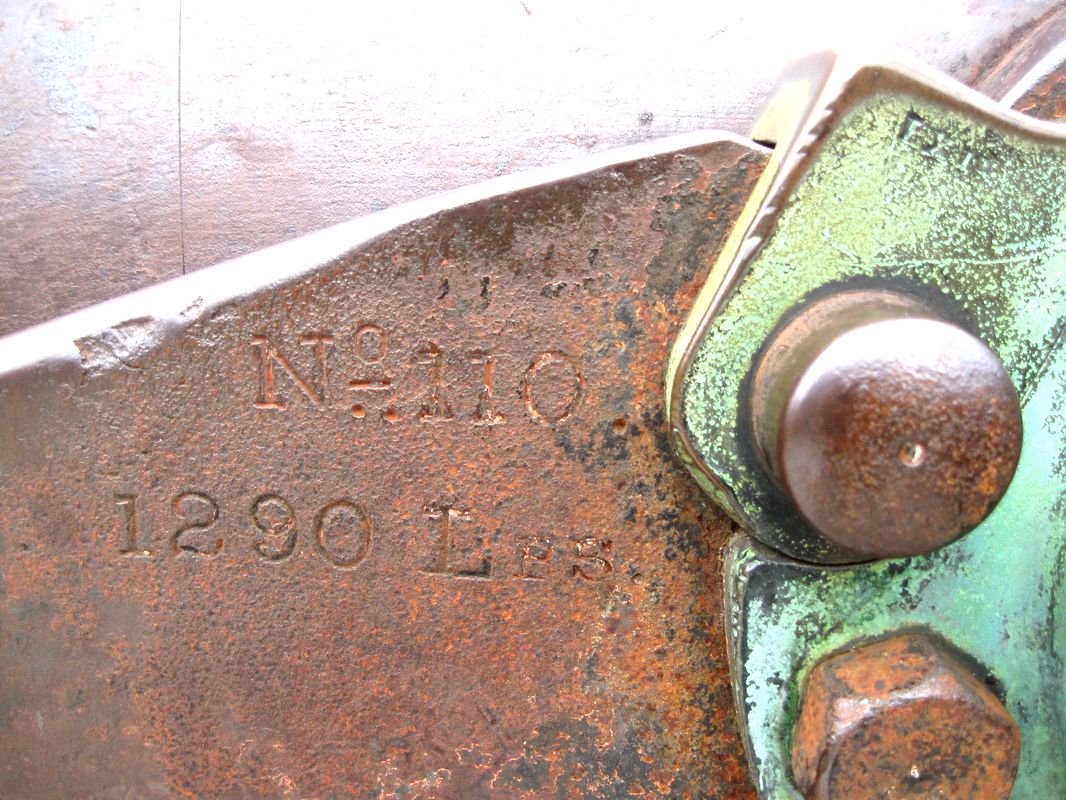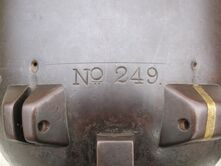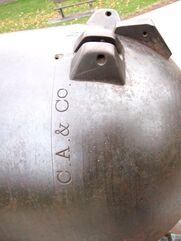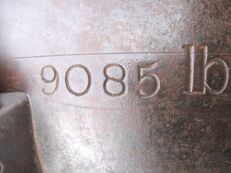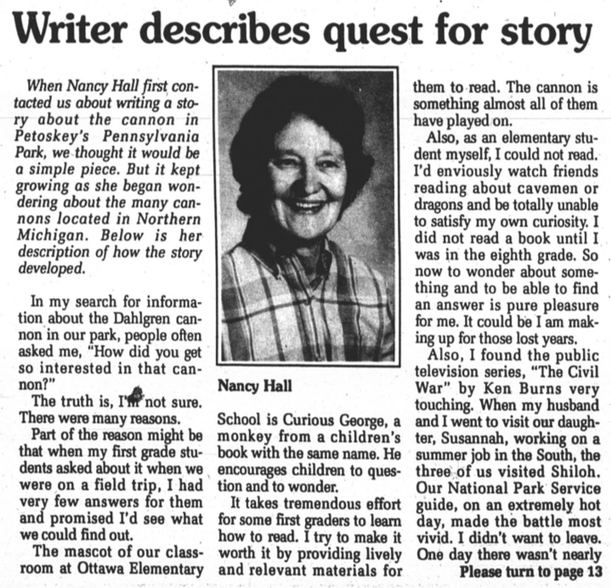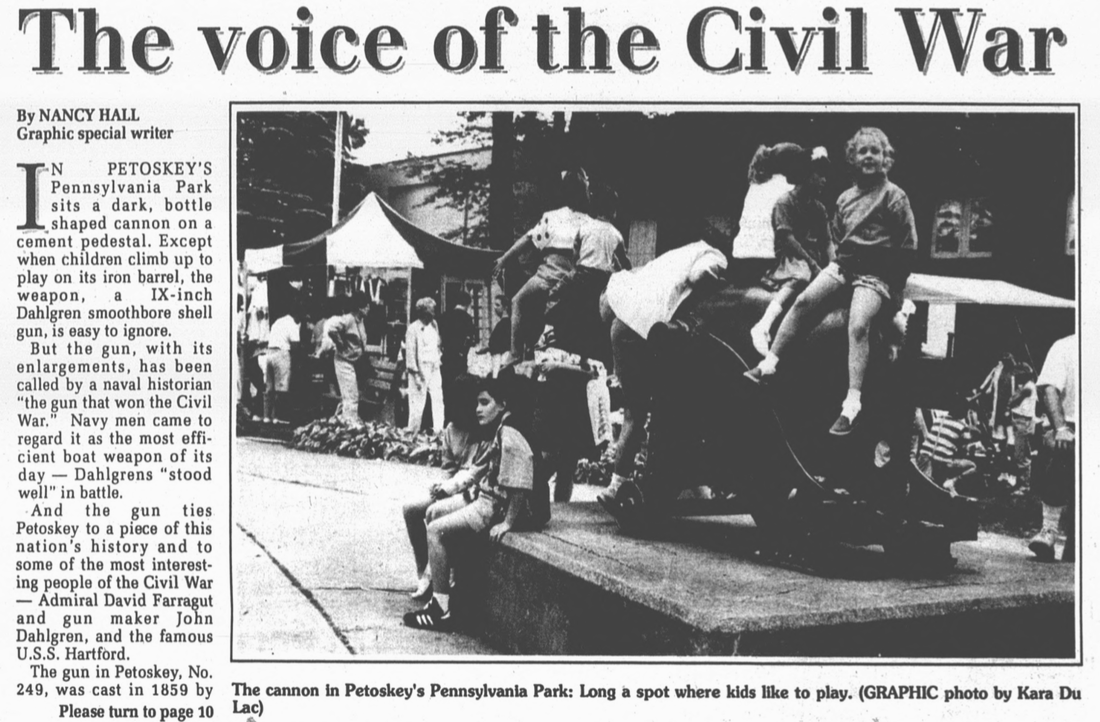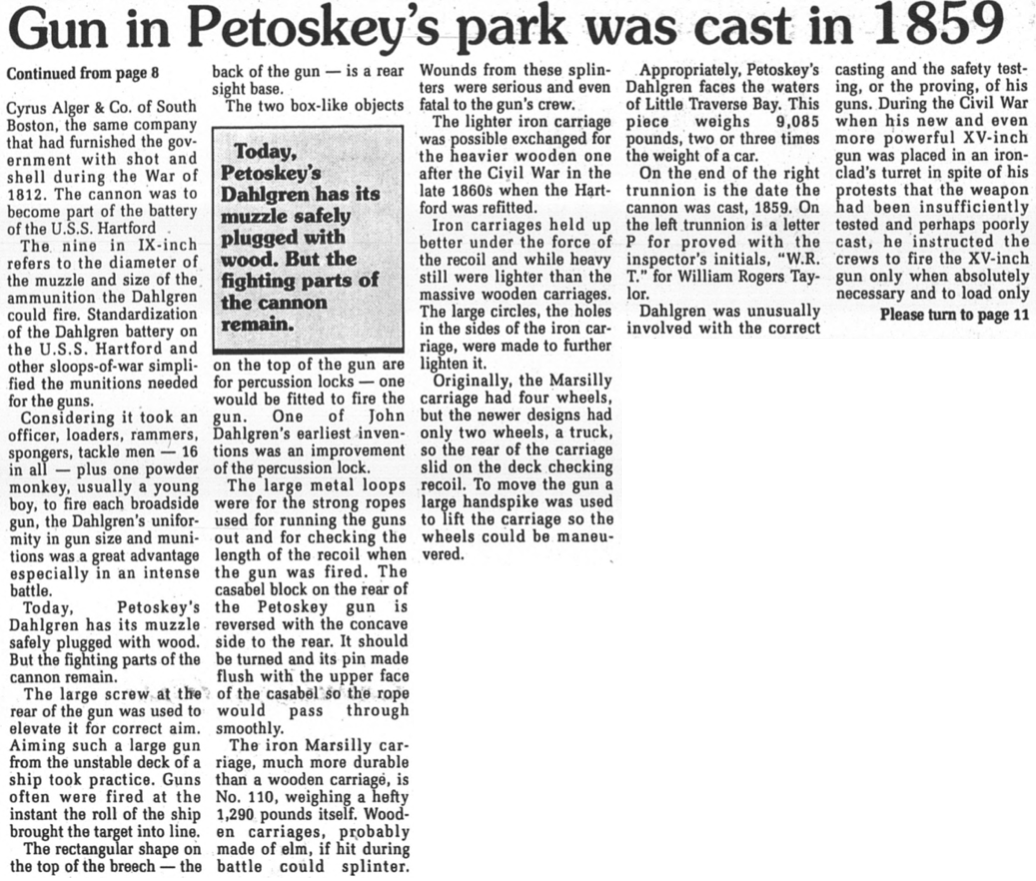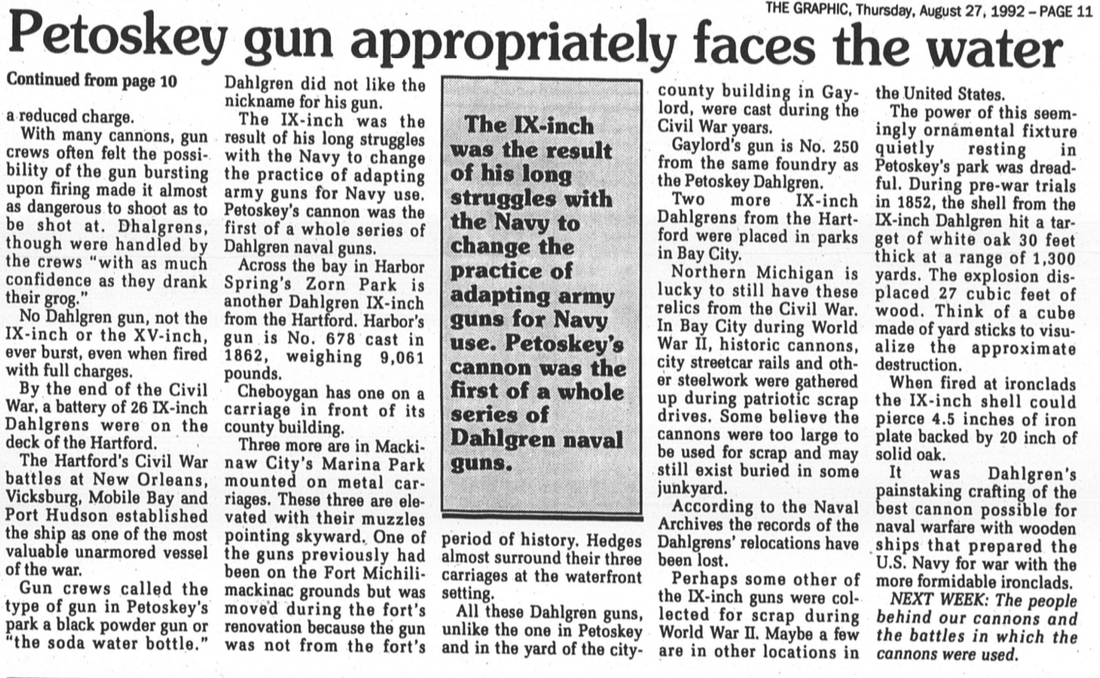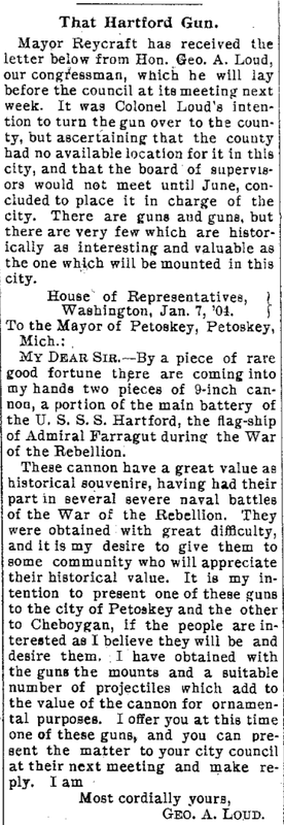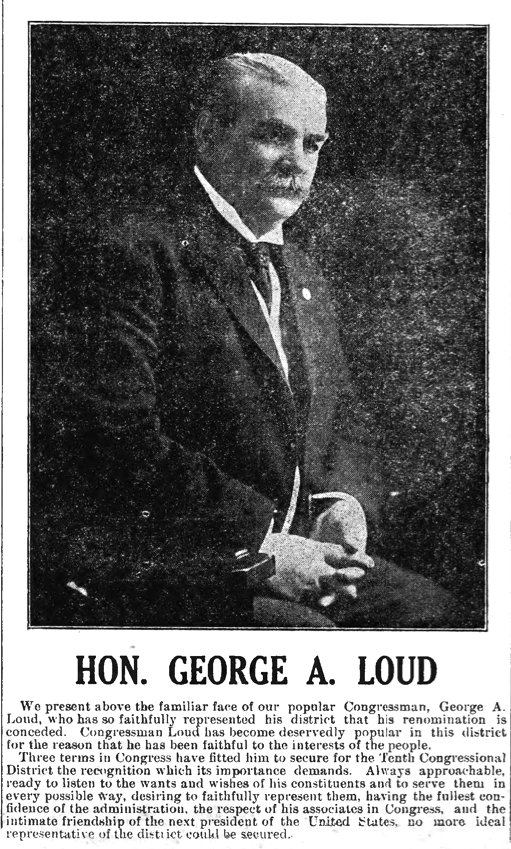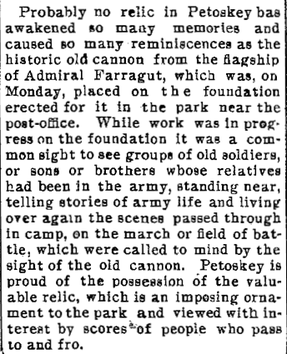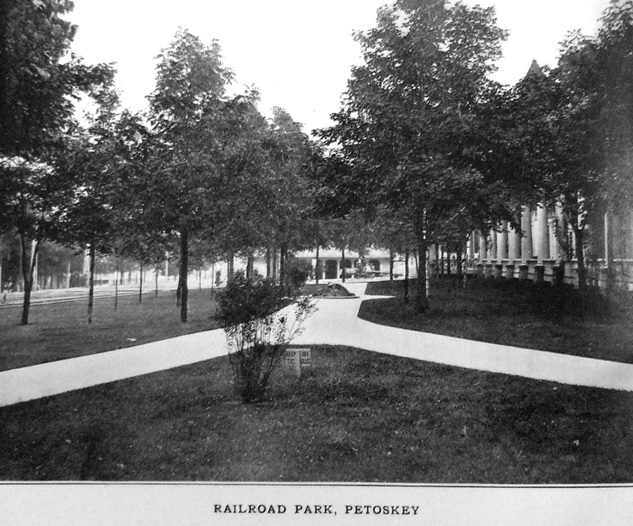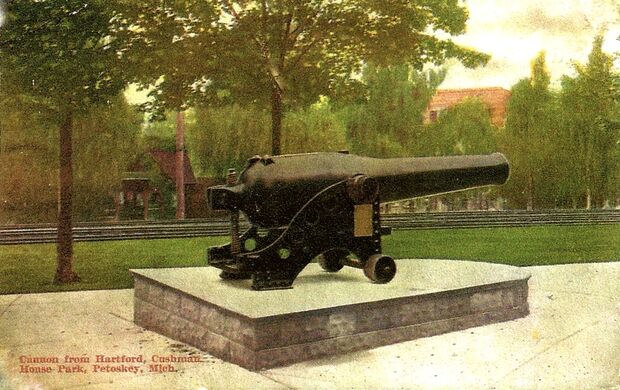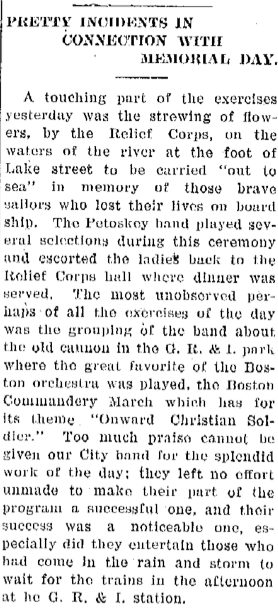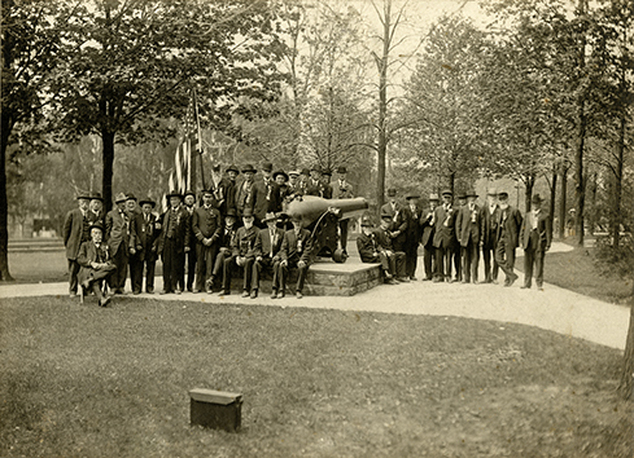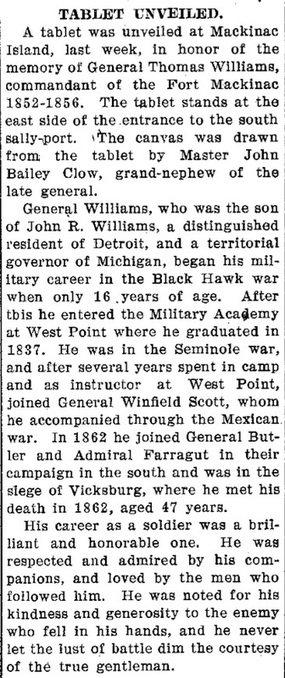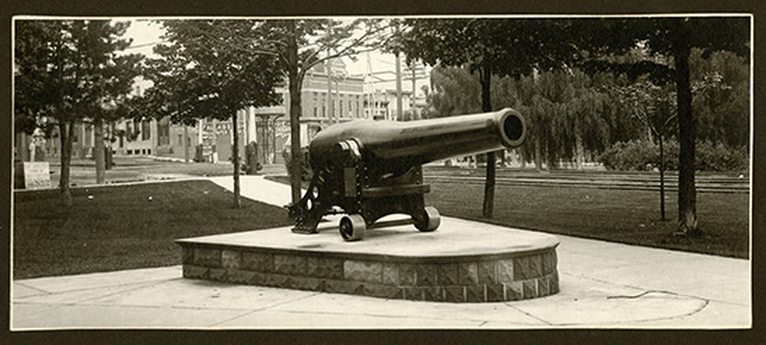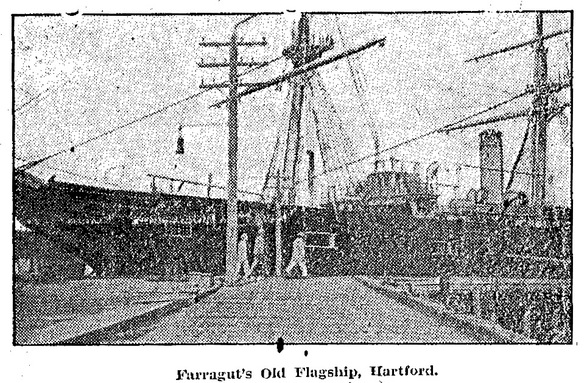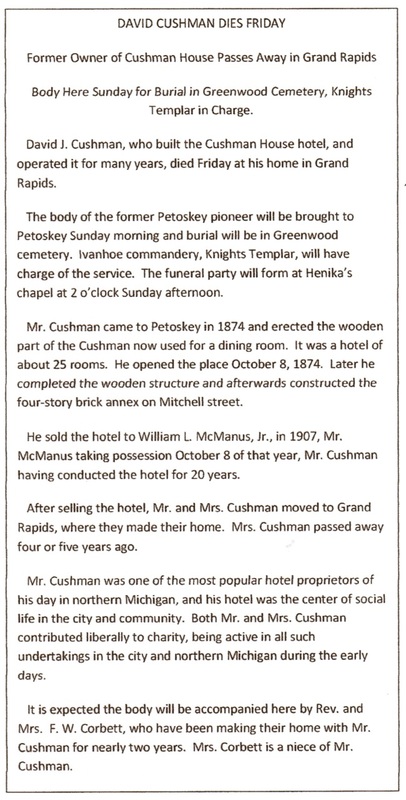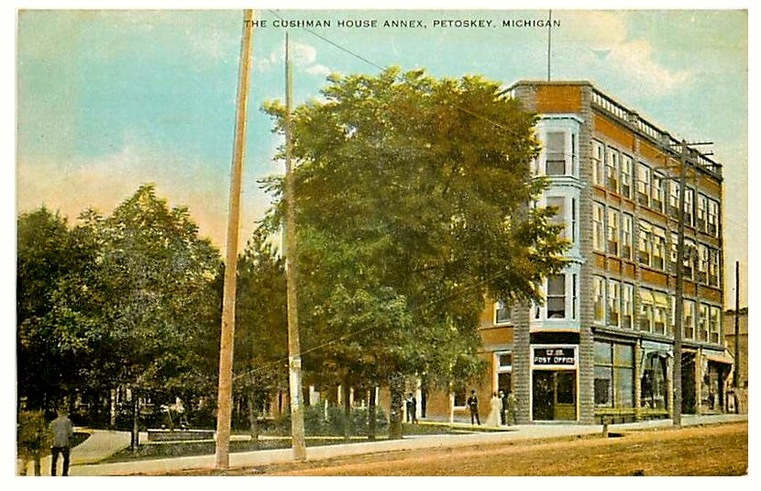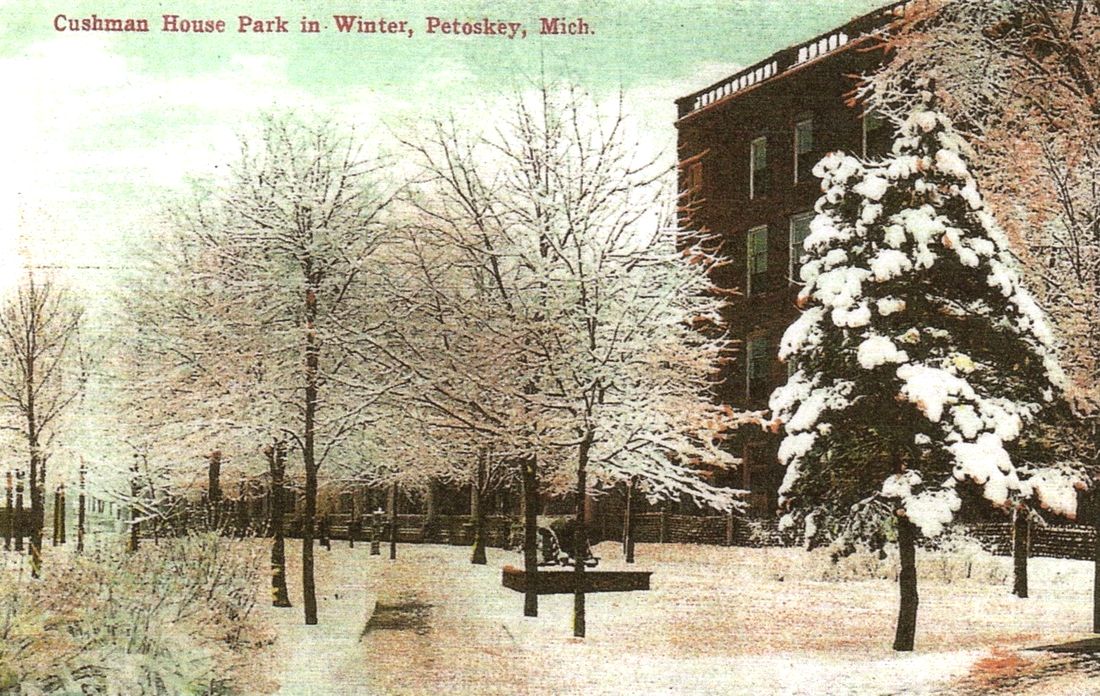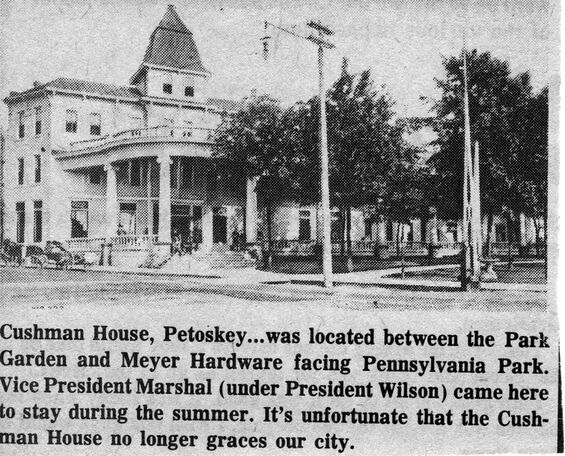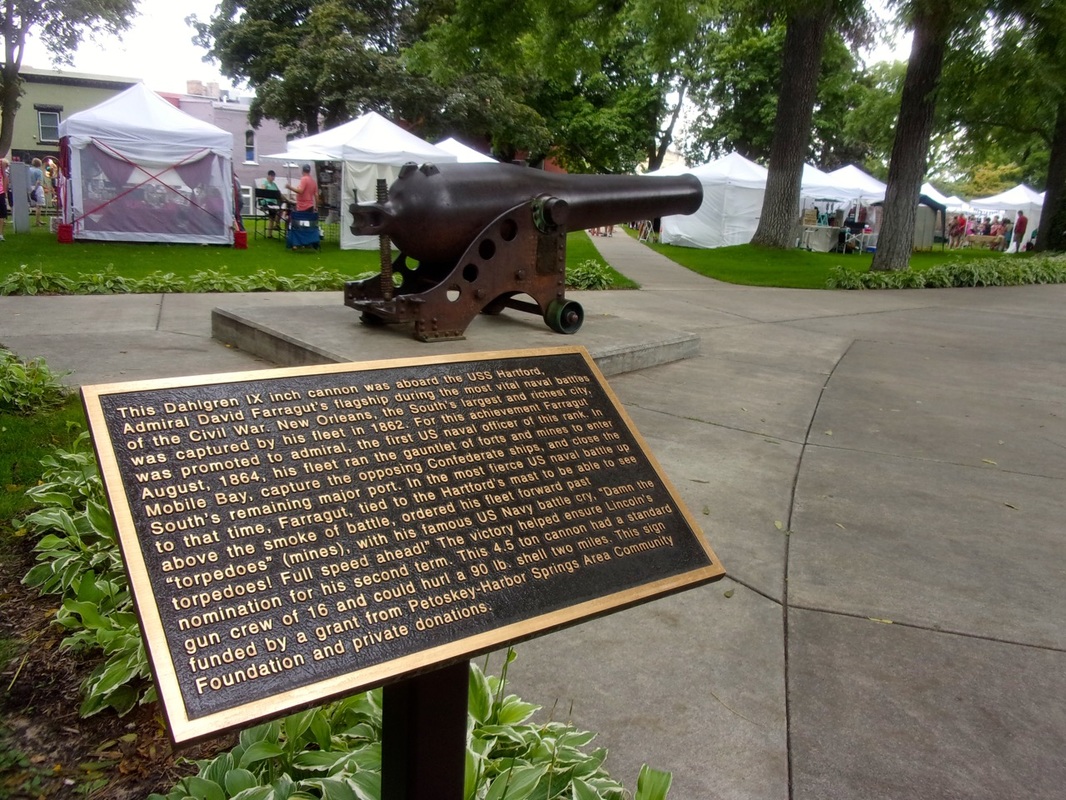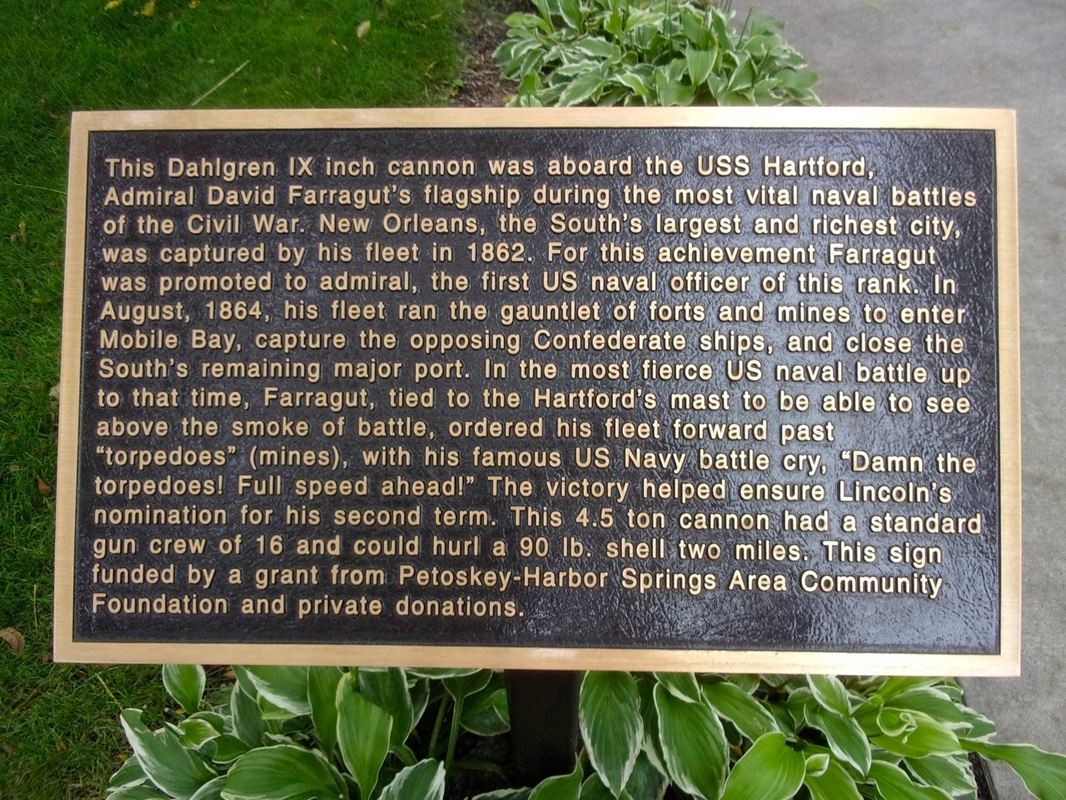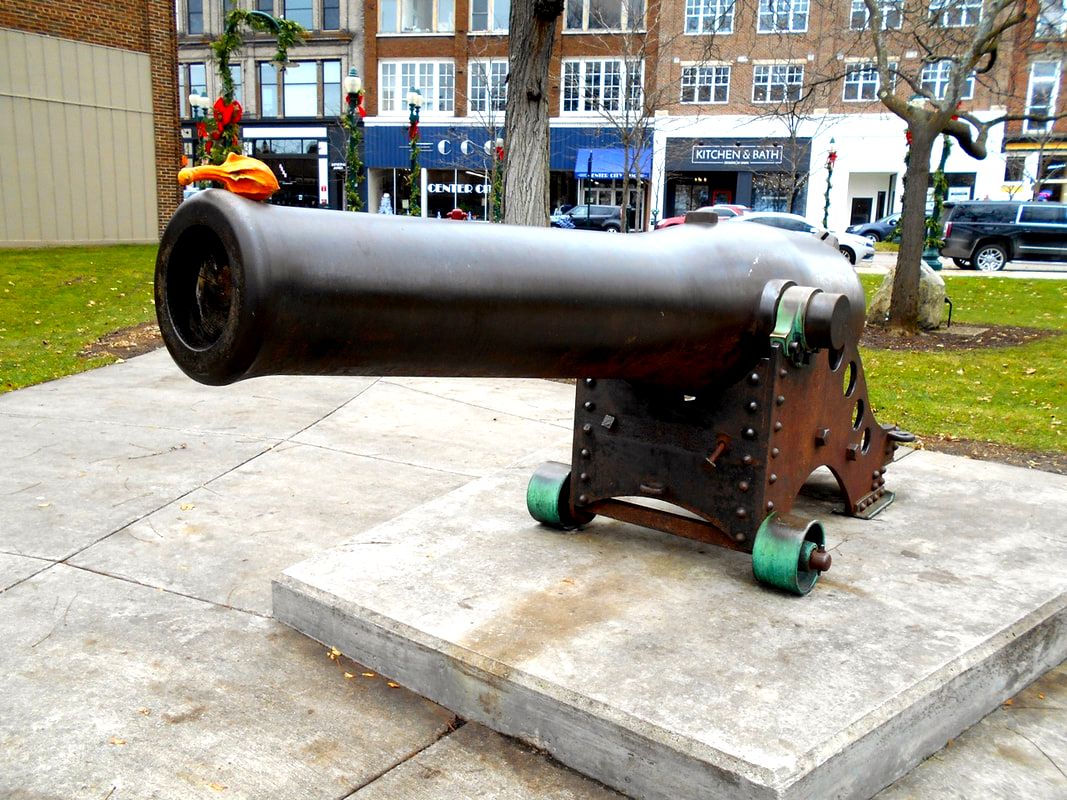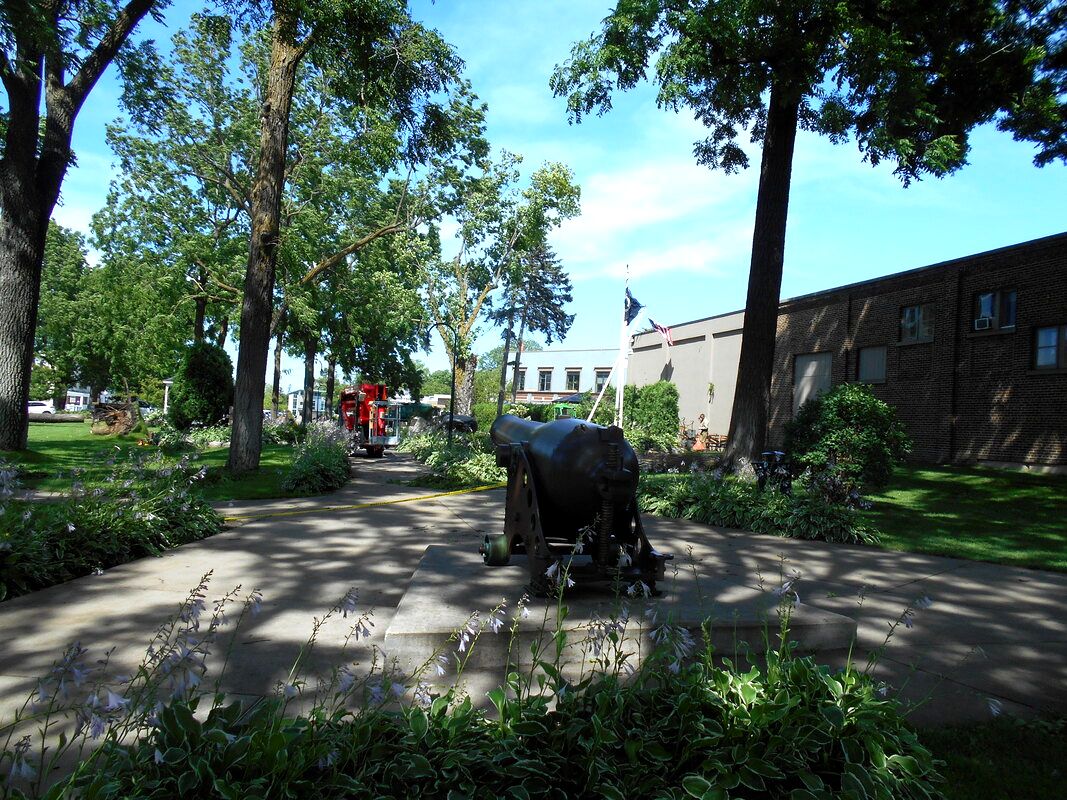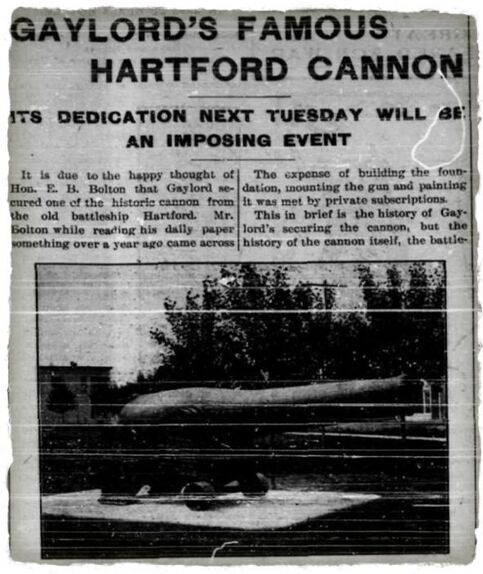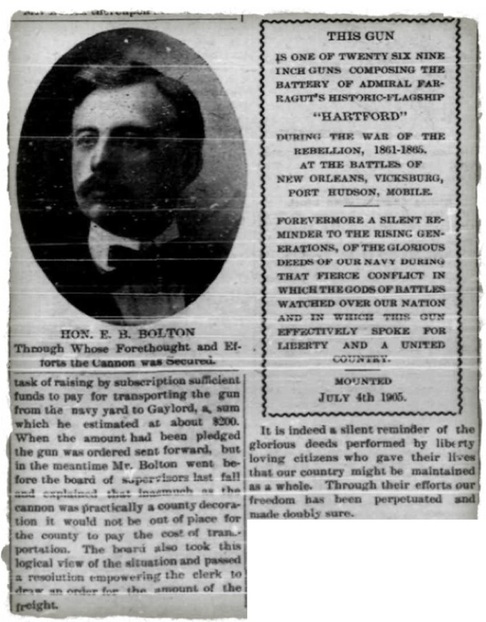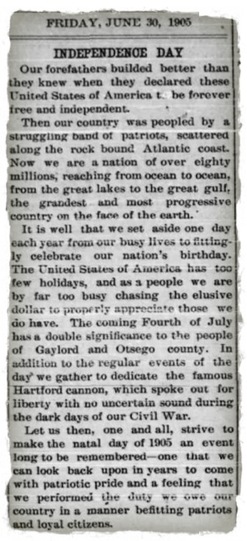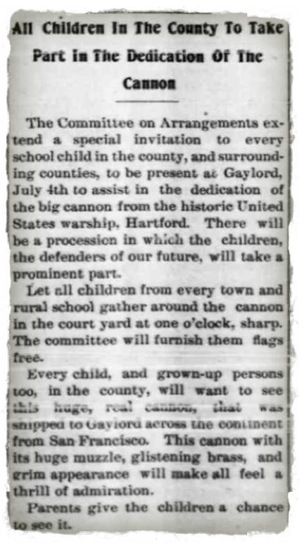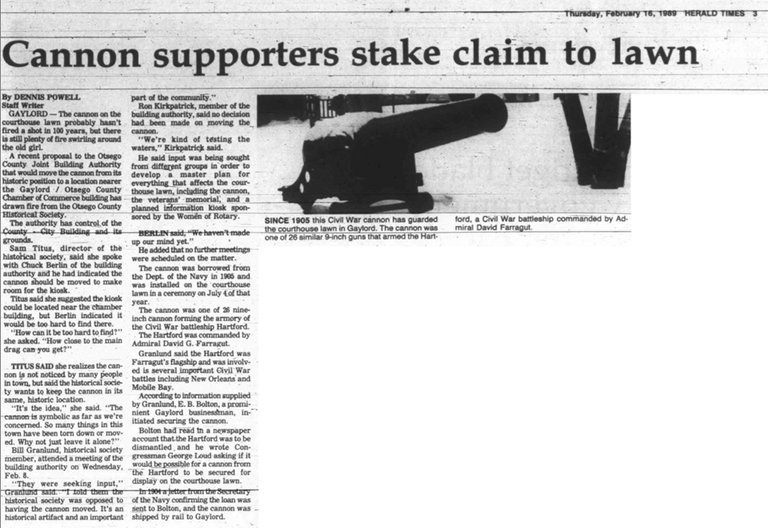Civil War
Pennsylvania Park ~ Petoskey MI
A Farragut Civil War Cannon is also found in Otsego County Gaylord MI...
some Gaylord information is posted toward the bottom of this webpage.
some Gaylord information is posted toward the bottom of this webpage.
Please do not copy the photos on this site, many of which have been submitted by private individuals...
just come back and visit the site often to view the photos.
just come back and visit the site often to view the photos.
Admiral Farragut's 9" Cannon
From Flagship "Hartford"
This photo above was taken after 1905 when the Farragut Cannon was set in the Pennsylvania Park.
This photo below was taken 10 July 2009 by Karla Howard Buckmaster of her grandson Keegan.
Every adult or child who passes this cannon wants to have a picture taken with the cannon at least once.
Every adult or child who passes this cannon wants to have a picture taken with the cannon at least once.
1909 Article Below: Officials received complaints that persons were
defacing the cannon in the park (beside the post office as seen in the photo above)
by scratching their initials and drawing pictures on it.
defacing the cannon in the park (beside the post office as seen in the photo above)
by scratching their initials and drawing pictures on it.
Photo Above: Names of four of the men were: ?, ?, Luinn Williams, ?, C.C. Eddy, R.B. Hinds, ?
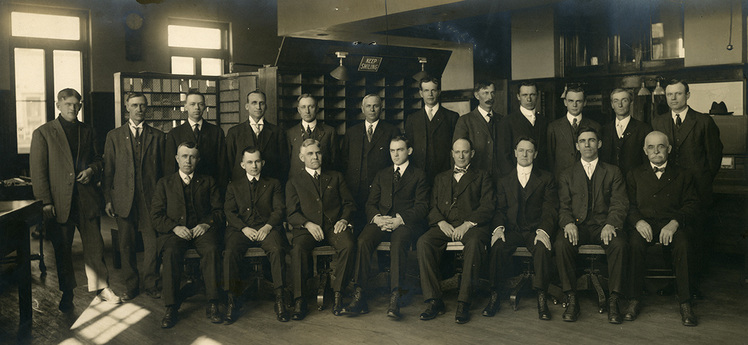 1914 ~ Men who worked in the US PO when located along the park beside the Cannon
1914 ~ Men who worked in the US PO when located along the park beside the Cannon
|
THIS GUN
Is One Of Twenty Six Nine Inch Guns composing the battery of ADMIRAL FARRAGUT'S historic flagship "HARTFORD" during the war of the rebellion, 1861-1865, at the battles of New Orleans, Vicksburg, Port Hudson, Mobile. _______________o_______________ Forevermore a silent reminder to the rising generations, of the glorious deeds of our navy dur- ing that fierce conflict in which the god of battles watch- ed over our nation and in which this gun effectively spoke for liberty and a united country. _______________o_______________ mounted July 4th 1905 |
This above USS Hartford (1858) Website lists sites in number order for the remaining 9" Cannons From Flagship "Hartford.
9" Dahlgren Cannons which served on USS Hartford survive at:
Hagerstown, Maryland- Tredegar Iron Works registry #117
Cheboygan, Michigan- Cyrus Alger & Co. #225
Mare Island, California- Cyrus Alger & Co. #228
Vallejo, California- Cyrus Alger & Co. #229
Hartford, Connecticut- Cyrus Alger & Co. #247 & #248
Petoskey, Michigan- Cyrus Alger & Co. #249 [Number 249 shown in photo below]
Gaylord, Michigan- Cyrus Alger & Co. #250
9" Dahlgren Cannons which served on USS Hartford survive at:
Hagerstown, Maryland- Tredegar Iron Works registry #117
Cheboygan, Michigan- Cyrus Alger & Co. #225
Mare Island, California- Cyrus Alger & Co. #228
Vallejo, California- Cyrus Alger & Co. #229
Hartford, Connecticut- Cyrus Alger & Co. #247 & #248
Petoskey, Michigan- Cyrus Alger & Co. #249 [Number 249 shown in photo below]
Gaylord, Michigan- Cyrus Alger & Co. #250
Markings on the 9" Cannon
From Flagship "Hartford"
This 9" cannon, No. 249 and Carriage No. 110-USS Hartford (SSN 208) #63-373-A, Ser Cu/0090, L-1-192-2760 is registered with the Department of Navy and currently on display in Pennsylvania Park.
Cast in 1859 by Cyrus Alger & Co., South Boston, MA, weighs 9,085 pounds;
carriage is No. 110 weighs 1,290 pounds.
Cast in 1859 by Cyrus Alger & Co., South Boston, MA, weighs 9,085 pounds;
carriage is No. 110 weighs 1,290 pounds.
All Civil War Cannon Above Photos Taken By Karla Howard Buckmaster
The Gun in the Park
The booklet, The Gun in the Park, about the Civil War Cannon in Pennsylvania Park, was masterfully researched and written several years ago, by now retired Petoskey elementary teacher Nancy Hall who has given permission for the following portion of her booklet to be posted only on this website. Nancy's husband John Hall helped to publish Nancy's extensive work in booklet form. Nancy has generously shared her booklet again, so others may learn and enjoy, giving permission for parts of her booklet to be included on this Charlevoix Emmet History website. About ten years ago, this booklet also was published in the Petoskey News Review's "The Graphic", put out over the summer in five parts. ~ Karla Howard Buckmaster, edited in 2013:
~~~~~~~~~~~~~~~~~~~~~
The Gun in the Park describes a "dark bottle-shaped gun on a cement pedestal. Except when children climb up to play on its iron barrel, the weapon, a IX-inch Dahlgren smoothbore shell gun, is easy to ignore. But this gun with its enlargements was called by a naval historian 'the gun that won the Civil War.' Navy men came to regard it as the most efficient boat weapon of its day; Dahlgrens 'stood well' in battle.
The gun in our park, No. 249, was cast in 1859 by the C.A. & Co, Cyrus Alger & Co. of South Boston, the same company that furnished the government with shot and shell during the War of 1812. The nine in IX-inch refers to the diameter of the muzzle and the size of the ammunition the Dahlgren could fire. Standardization of the Dahlgren battery on the Hartford and other sloops-of-war simplified the munitions needed for the guns. Considering it took an officer, loaders, rammers, spongers, tackle men, 16 in all, plus one powder monkey, a young boy, to fire each broadside gun, Dahlgren's uniformity of gun size and their munitions was a great advantage, especially in an intense battle.
Now our Dahlgren has its muzzle safely plugged with wood. The large screw at the rear of the gun was used to elevate the gun for correct aim. Aiming such a large gun from the unstable deck of a ship took practice; guns were often fired at the instant the roll of the ship brought the target into line. The rectangular shape on the top of the breech, the back of the gun, is a rear sight base. The two box-like objects on the top of the gun are for percussion locks; one would be fitted to fire the gun. One of John Dahlgren's earliest inventions was an improvement of the percussion lock. The large metal loops were for the strong ropes used for running the guns out and for checking the length of the recoil when the gun was fired. The casable block on the rear of our gun is reversed with the concave side to the rear. It should be turned and its pin made flush with the upper face of the casable so the rope would pass through smoothly.
The iron Marsilly carriage, much more durable than a wooden carriage, is No. 110 weighing a hefty 1,290 pounds itself. Wooden carriage (probably of elm), if hit during battle, could splinter. Wounds from these splinters were serious and even fatal to the gun's crew. The lighter iron carriage was possibly exchanged for the heavier wooden one after the Civil War in the late 1860's when the Hartford was refitted. Iron carriages held up better under the force of the recoil and, while heavy, were lighter than the massive wooden carriages. The large circles, holes in the sides of the iron carriage, were to further lighten it.
Originally the Marsilly carriage had four wheels, but the newer designs had only two wheels, a truck, so the rear of the carriage slid on the deck, checking recoil. To move the gun a large handspike was used to lift the carriage so the wheels could be maneuvered.
Appropriately the Dahlgren faces the waters of Little Traverse Bay. This piece weighing 9,085 pounds, two or three times the weight of a car, with its side projections, its trunnions, resting on the carriage, was a naval gun. On the end of the right trunnion is the date the cannon was cast, 1859; on the left trunnion is a letter 'P' for 'proved' with the inspector's initials, 'W.R.T.' for William Rogers Taylor….
Our gun was the first of a whole series of Dahlgren naval guns.
Across the bay in Harbor Spring's Zorn park is another Dahlgren IX-in. from the Hartford. Harbor's gun is No. 678, cast in 1862, weighing 9,061 pounds. Cheboygan has one on a carriage in front of its County Building. Three more are in the marina park at Mackinaw City mounted on metal carriages. These three are elevated with their muzzles pointing skyward. One of the three had previously been in the Fort Michilimackinac grounds but was moved during the fort's renovation because the gun was not from the fort's period in history. Hedges almost surround the three carriages at the waterfront setting. All these Dahlgren guns except the ones in Petoskey and in the yard of City-County Building in Gaylord were cast during the Civil War years. Gaylord's gun is No. 250 from the same foundry as the Petoskey Dahlgren. Two more IX-in Dahlgrens from the Hartford were placed in parks in Bay City. The Civil War gun in the Veteran's Park in Boyne City is a land artillery piece, a Columbiad on a metal Barbette Carriage which may have been mounted on a pivoting mechanism.
We are lucky to have these relics from the Civil War in Northern Michigan….
Our gun in the park and the two in Bay City park were brought here during the winter of 1904-1905 from Mare Island navy yard in California. Our gun was placed in the park May 29, 1905 and dedicated on July 4, 1905. Congressman George A. Loud and our local Postmaster at the time, James Buckley, are credited with obtaining these guns for Michigan. The metal tablet on the carriage of many of the Dahlgrens in Michigan explain about the gun and the Hartford. These plaques were cast at the Industrial Works in Bay City…
As the gun rests in our park its fierce battles over and with a memorial to the dead from another war nearby, Farragut's words are appropriate: 'The best gun and the best vessel should certainly be chosen, but the victory three times out of four depends upon those who fight them.'"
~~~~~~~~~~~~~~~~~~~~~
Nancy Hall's The Gun in the Park also includes sections (not included on this website) about Naval Battles Our Cannon Participated In (led by Flag Officer Farragut on the Hartford), The Invention and Testing of the IX-Inch Dahlgren, Lincoln's Reliance on Dahlgren, Admiral Dahlgren and His Family, and The Hartford and the Union Navy. This is a valuable piece of work preserving the history for posterity of The Gun in the Park… Pennsylvania Park in Petoskey Michigan.
Article Below: Petoskey's Mayor Reycraft received the letter from Hon. George A. Loud who intended to turn "the gun" over to the county, but because the county had no available location for the cannon in the city, Hon. Loud concluded to place the cannon in charge of the city.
One has to wonder after reading the article above,
just whatever has happened to the "projectiles (cannonballs?)
which were donated with the Hartford Cannon to the City of Petoskey.
If anyone knows, contact here.
just whatever has happened to the "projectiles (cannonballs?)
which were donated with the Hartford Cannon to the City of Petoskey.
If anyone knows, contact here.
Admiral Farragut's 9" Cannon From Flagship "Hartford" Set 29 May 1905
(in front of the Petoskey Post Office near the Cushman Hotel).
 21 June 1905 ~ The Petoskey Record
21 June 1905 ~ The Petoskey Record
The Supplement to The Petoskey Record may be accessed on the Greenwood website which hosts the Petoskey newspapers. This supplement was published 21 June 1905 shortly before the dedication of the cannon to be set in Petoskey's Cushman House Park on 4 July 1905.
Original Setting Of Civil War Cannon
Called Cushman House Park
(Photo above from "Summer Resorts on Little Traverse Bay" published in 1902)
A copy of the above 1913 photo of the cannon in Pennsylvania Park
was located in the Boyne City MI Museum.
On the back was written: "Daniel Tainter (see biography below) second from right with feet crossed."
The Grand Army of the Republic Civil War Veterans from Emmet County,
pose with the cannon that was donated July 4, 1905, by the Women's Relief Corps.
was located in the Boyne City MI Museum.
On the back was written: "Daniel Tainter (see biography below) second from right with feet crossed."
The Grand Army of the Republic Civil War Veterans from Emmet County,
pose with the cannon that was donated July 4, 1905, by the Women's Relief Corps.
It was written in the Biographical Story of Northern Michigan (published 1905) about this Daniel Tainter:
"Another of the sterling pioneers of Charlevoix county is Daniel Tainter, whose fine farm property is located in Evangeline township, where he has resided for more than thirty years. In 1871 he came to this county and took up a homestead of one hundred and sixty acres two miles northeast of the present village of Boyne City, while he was one of the first veterans of the Civil war to here avail himself of the privilege of taking up such a homestead as a soldier's claim. On this original homestead he has ever since continued to reside, while through his earnest and well-directed efforts he has developed a good farm from the land which was covered with a dense growth of native timber at the time when he here erected his little log domicile and prepared himself to grapple with the wilderness. He has sold sixty acres of his land, so that his homestead now comprises one hundred acres, of which about seventy acres are under effective cultivation, while the permanent improvements are of excellent order.
...In 1861 he enlisted in Company C, Second Michigan Volunteer Infantry, with which he proceeded to the front, and with which he continued in active service for three years, at the expiration of which he received his honorable discharge. He was with his command in Virginia for eighteen months, ---up to the time Kearney was killed. His regiment had been a part of the Third Corps until this time, and was then transferred to the Ninth Corps, under Burnside, with whose forces the regiment proceeded into Kentucky and then to Vicksburg, after which they returned to Kentucky and thence marched to Knoxville, Tennesee, participating in numerous skirmishes beside the greater conflicts in which the command was involved. Mr. Tainter was wounded in an engagement at Campbell Station, where he received a musket ball in the shoulder, being incapacitated for active service for a time and then rejoining his regiment, with which he remained until he was mustered out, having taken part in fifteen battles and having proved himself a loyal and ideal soldier of the republic.
...On December 10, 1865, Mr. Tainter was united in marriage to Miss Eliza A. Hull, and of their four children we record that Herbert is in the employ of W.H. White, of Boyne City; Madge L. is the wife of Melza Brown, of Kalamazoo, this state; and Fred N. and Alice remain at the parental home, the latter being a successful teacher in the public schools of the locality."
"Another of the sterling pioneers of Charlevoix county is Daniel Tainter, whose fine farm property is located in Evangeline township, where he has resided for more than thirty years. In 1871 he came to this county and took up a homestead of one hundred and sixty acres two miles northeast of the present village of Boyne City, while he was one of the first veterans of the Civil war to here avail himself of the privilege of taking up such a homestead as a soldier's claim. On this original homestead he has ever since continued to reside, while through his earnest and well-directed efforts he has developed a good farm from the land which was covered with a dense growth of native timber at the time when he here erected his little log domicile and prepared himself to grapple with the wilderness. He has sold sixty acres of his land, so that his homestead now comprises one hundred acres, of which about seventy acres are under effective cultivation, while the permanent improvements are of excellent order.
...In 1861 he enlisted in Company C, Second Michigan Volunteer Infantry, with which he proceeded to the front, and with which he continued in active service for three years, at the expiration of which he received his honorable discharge. He was with his command in Virginia for eighteen months, ---up to the time Kearney was killed. His regiment had been a part of the Third Corps until this time, and was then transferred to the Ninth Corps, under Burnside, with whose forces the regiment proceeded into Kentucky and then to Vicksburg, after which they returned to Kentucky and thence marched to Knoxville, Tennesee, participating in numerous skirmishes beside the greater conflicts in which the command was involved. Mr. Tainter was wounded in an engagement at Campbell Station, where he received a musket ball in the shoulder, being incapacitated for active service for a time and then rejoining his regiment, with which he remained until he was mustered out, having taken part in fifteen battles and having proved himself a loyal and ideal soldier of the republic.
...On December 10, 1865, Mr. Tainter was united in marriage to Miss Eliza A. Hull, and of their four children we record that Herbert is in the employ of W.H. White, of Boyne City; Madge L. is the wife of Melza Brown, of Kalamazoo, this state; and Fred N. and Alice remain at the parental home, the latter being a successful teacher in the public schools of the locality."
Article Below: General Thomas Williams, commandant of the Fort Mackinac 1852-1856, began his military career in the Black Hawk War when only 16 years of age. He also served in the Seminole War, was an instructor at West Point, and joined General Winfield Scott through the Mexican War. In 1862 he joined General Butler and Admiral Farragut in their campaign in the south and was in the siege of Vicksburg, where he met his death in 1862, aged 47 years. So General Thomas Williams served with Admiral Farragut who used the cannon that now rests in Pennsylvania Park Petoskey MI.
The photo below of Farragut's Old Flagship, Hartford, accompanied the article in the 3 August 1910 The Petoskey Record. The article was titled Interesting Story of Uncle Sam's Big School---Congressman Loud Writes Entertainingly of His Trip as Official Visitors for the United States Government. Congressman Loud was the one credited with attaining the Farragut cannon which stands guard in Petoskey's Pennsylvania Park as described in the 21 June 1905 newspaper posted above.
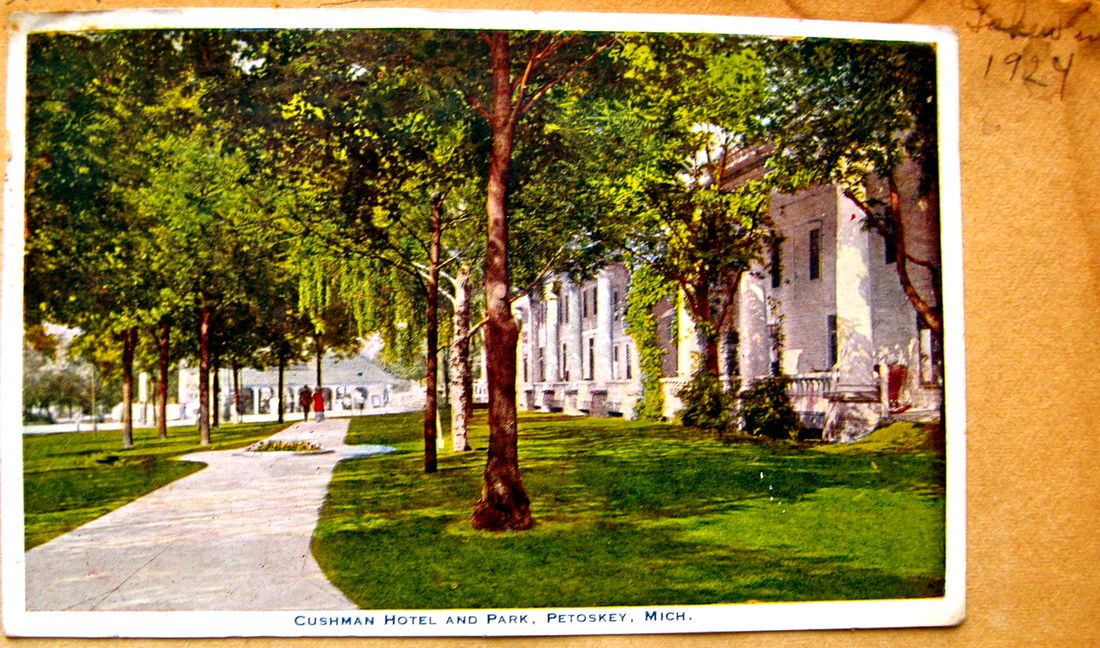
Taken in 1924 according to Howardine Plumb's handwriting in her scrapbook beside this postcard showing that the main park in Petoskey was still called the Cushman Park. This photo shows the area where many of the military memorials are located in 2013. A different postcard (from about 1905, but not shown here) of the Cushman House titled the park as the "G.R. & I. Park".
The Cushman House building was erected in 1874 by David J. Cushman, himself a Civil War veteran.
Mr. Cushman, a native of Canada had come to Michigan in 1856.
David Cushman's brother George Henry Cushman (1840 ~ 1910) was for a short time connected to the Cushman House.
He later sold his interest, and built the residence on 201 Division Street in Petoskey.
George Henry Cushman was a Civil War veteran as well.
This page of Statues of War-time Heroes, including that of Admiral Farragut, was published 25 May 1910 in The Petoskey Record on page 6.
A descriptive plaque was placed in Pennsylvania Park near the cannon in August 2016. Click on the photos below to read the plaque.
Photo Below: Sadly, after the horrific 2020 wind/rain storms in a 24 hour timeframe on 18-19 July 2020 traveling through Petoskey and its Pennsylvania Park, the cannon aims at uprooted Old walnut trees and a listing pole with the American Flag... in the process of being cleaned and restored.
GAYLORD'S FAMOUS HARTFORD CANNON
The 30 June 1905 Otsego County Herald published the following article about the Gaylord MI Hartford Cannon. The article gives an accounting of the acquisition of the cannon, and tells briefly of the cannon's history which would be similar to that of Petoskey's Hartford Cannon. It seems both the Gaylord, and the Petoskey, cannons were dedicated on the same July 4, 1905.
